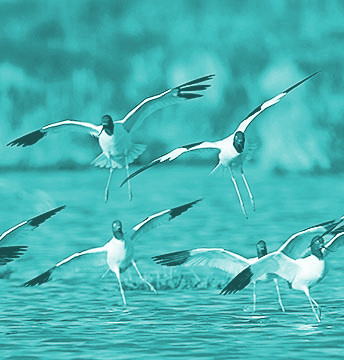Algae concerns after Coorong count
 A new survey suggests algae has negatively affected migratory bird numbers in at the mouth of the Murray.
A new survey suggests algae has negatively affected migratory bird numbers in at the mouth of the Murray.
The study by Ecologist David Paton - who has been counting bird numbers annually since 1985 in the lagoons and wetlands of the Coorong system - has confirmed previous findings by the Murray-Darling Basin Authority.
He says international migratory shorebird numbers in the Coorong and Lower Lakes at the mouth of the Murray are at the lowest levels on record.
The University of Adelaide associate professor said dense algae is making it difficult for shorebirds and the vegetation they feed on.
“Filamentous green algae has never been here except for the last few years,” Dr Paton has told reporters.
“That's now so abundant it's causing problems for some of those migratory shorebirds and their food supply.”
Red-necked stints and curlew sandpipers are among several species that fly thousands of kilometres from China, Korea and Japan to Australian wetlands in the summer.
Australia has an international legal obligation to protect the Coorong, as it is a Ramsar-listed site.
One of the aims of the Murray-Darling Basin Plan, introduced five years ago, is to overcome years of reduced water flows down the Murray.
“China and Japan and Republic of Korea would be horrified to think that Australia is just ignoring these international agreements that we've signed with them saying we'll look after the habitats of these shorebirds,” Dr Paton said.
“The damage might well have been done to this international wetland.
“This might not be able to be removed now and it's a great shame.
“We have these so-called pieces of legislation and both state and federal governments ignore it when it comes to looking after an asset that's this important for migratory shorebirds.”
A spokesperson from the Murray-Darling Basin Authority has told reporters that conditions in the Coorong should improve in the years ahead.
“It will take time to turn around long-term trends like this, but the Basin Plan remains our best chance of securing a sustainable future for the Murray-Darling Basin's diverse flora and fauna,” the spokesperson said.
“By 2019, we are aiming to see populations of key shorebird species maintained.”
Dr Paton also says the $60 million South East Flows Restoration Project, which is funded with both state and federal money, has channelled drainage water from farms into the southern Coorong.
SA Environment Department head of River Murray operations Andrew Beal says evidence contradicts Dr Paton’s theory.
“Recent findings by the Adelaide University have concluded that there's a net export of nutrients by introducing that water — it has both a diluting and exporting effect, which in the total scheme of things is a positive thing,” Mr Beal said.
“It will never go back to its original pristine condition, but I think we can have a very healthy Coorong and Lower Lakes, albeit it's going to take time because the condition that the system was in at the end of the millennium drought was severely degraded.”








 Print
Print